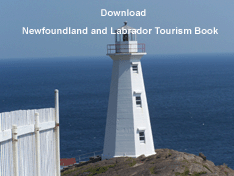Rose Blanche Lighthouse Scenic Drive
Distance - 45km
Granite Sentinel
This tour takes you from the ferry terminal at Port aux Basques to the Rose
Blanche lighthouse 45 km to the east along Route 470. On this side trip you will
see dark cliffs, crashing waves, spume and spray. The real spirit and traditions
of outport Newfoundland survive in the small fishing villages that cling
tenaciously to the rocky, exposed shores of the southern coastal plain.
The Rose Blanche Lighthouse has one of the best scenic views of the Cabot
Strait. A three-year reconstruction of the granite lighthouse, which went into
service in 1873, was completed in 1999.
Early mariners like Sir Humphrey Gilbert, Jacques Cartier and Captain John Mason
explored this rugged coast more than 400 years ago. Many of the community names
in the area are English versions of the original French or Basques names given
them by the area's first settlers.
Rose Blanche is named for the white granite -
in French rock is roche, and in English roche has been changed to rose - that
the community is built on.
Rose Blanche is the western terminus for the coastal boat that services isolated
communities along Newfoundland's south coast. From here you can catch a boat six
days a week to La Poile where you can experience a different
kind of lifestyle. There is also a trip from Grand Bruit to
Burgeo, further
east, on the day when Rose Blanche is not serviced Other boats from Burgeo
travel east to Hermitage-Sandyville.
After leaving Rose Blanche and heading west, Harbour Le Cou, celebrated in the
Newfoundland folk song of the same name, also bears witness to the French
element on this shore. Along Route 470, you will pass through a number of small
fishing communities including Diamond Cove, and Burnt Islands. Be sure to
explore the unique heath-covered terrain of coastal Newfoundland before you
continue on to
Isle aux Morts, or Island of the Dead. This community earned its
macabre name because of the number of marine disasters that happened in the
treacherous waters offshore.
This coastal area has a long history of death and disaster, with the wrecks of
no fewer than 40 ships said to be lying at the bottom of the Cabot Strait. These
tragedies have given rise to many traditional songs and stories of lost ships
and courageous rescues at sea. There is none as moving as the true story of
George Harvey, his son and his daughter, Ann. In 1828, these brave residents of
Isle aux Morts saved nearly the entire complement of passengers and crew from
the sinking Despatch by stringing a lifeline from the ship to the shore with the
help of their valiant Newfoundland dog. The local heroes' courage was recognized
by King George IV who awarded the Harvey's a medal of bravery.
After passing the community of Margaree-Fox Roost, it's back to Channel-Port aux
Basques. Situated on the southwest coastal plain, this was a fishing station for
the French, Portuguese and Basques as early as the 16th century. While it is
named for the Basques, it was hardly their only port: research in Spanish
archives uncovered information that Basques whalers and fishermen occupied at
least seven islands on Newfoundland's west coast and in southern Labrador. Port
aux Basques is the principal Marine Atlantic ferry terminal in the province.
There's a boardwalk between the ferry terminal and Scott's Cove Park where you
can stretch your legs.
The community museum houses two rare 17th century astrolabes, early marine
navigational instruments - only 33 are known to exist worldwide - and both were
found by a local diver.
The Gulf Museum also boasts a 100-year-old diving suit.
While in Port aux Basques you can also visit Memorial Park featuring monuments
for the S.S. Caribou and World Wars I and II. Before getting back on Route 1,
drop by the Railway Heritage Centre for a guided tour of the restored train
filled with artifacts from a century ago.
Channel-Port aux Basques is the western end of
T'Railway Provincial Park, a
545-mile jaunt through the wilderness that follows the abandoned Newfoundland
Railway line all the way to St. John's. It's part of the Trans-Canada Trail.
Just west of Port aux Basques are the beaches at Grand Bay West, home to the
endangered Piping Plover. These are among the best of the relatively few sandy
beaches in Newfoundland. Here also you will find another feature rare in
Newfoundland: salt marshes. These marshes attract many different kinds of
shorebirds and waterfowl because of their lush growth. This southwestern corner
of Newfoundland is a great place to see birds during the spring and fall migrations.
Copyright © 2010, BNE-Web-Creations
Home ::
Avalon ::
Eastern ::
Central ::
Western ::
Labrador ::
Getting Here ::
Pictures ::
Contact Us ::
Site Map ::
Privacy Policy ::
Disclaimer ::
Terms Of Use
